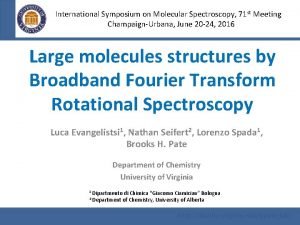VIII INTERNATIONAL ARGICULTURE SYMPOSIUM AGROSYM 2017 5 8

- Slides: 1

VIII. INTERNATIONAL ARGICULTURE SYMPOSIUM “AGROSYM 2017” 5 -8 October 2017, Jahorina, Bosnia and Herzegovina THE EFFECT OF TWO ROTATION SYSTEMS ON ROUGHAGE, ENERGY AND PROTEIN FEED YIELD IN ORGANIC FORAGE CULTIVATION Ahmet Esen ÇELEN 1 Ülfet ERDAL 2 1 Ege University, Faculty of Agriculture, Department of Field Crops, Izmir/Turkey 2 International Agricultural Research and Training Center, Izmir/Turkey Corresponding author: esen. celen@ege. edu. tr INTRODUCTION Crop rotation has a key role in improving the soil and increasing the yield. Crop rotation with legumes, recycling of crop residues and the application of organic manure must form the basis of nutrient management in organic farming. Presence of legumes in rotation may serve as the primary source of nitrogen for subsequent crops. The objective of this research was to determine the effect of two different rotation systems on the roughage, energy and protein feed yields in organic feed cultivation. MATERIALS AND METHODS This study was conducted in Menemen Plain, in Aegean Region, Izmir, Turkey during a period of 4 years between 2013 and 2016. Trial was conducted in the randomised complete block design with four replications. The first rotation system consisted of vetch/triticale mixture - cotton, persian clover - maize silage, vetch/triticale mixture - cotton and persian clover - maize silage while the second alternation system consisted of vetch/triticale mixture - soybean, vetch/oats mixture - corn, vetch/triticale mixture - soybean and vetch/oats mixture - corn for the first, second, third and fourth years, respectively. Plot size was 2. 8 m x 5 m = 14 m 2. According to the results of soil analysis, certified organic fertilizer containing 2% N, 2. 5% P 2 O 5, 2. 5% K 2 O, 60% organic matter and 9/12 C/N was applied to the plots. Vetch/triticale, vetch/oat, persian clover and maize silage were harvested as hay whereas cotton, soybean and corn were harvested as seed in both rotation systems. RESULTS AND DISCUSSION In the first rotation system, fresh herbage yields of vetch/triticale mixture and Persian clover decreased in consecutive years. However, both cotton seed and silage maize yields increased. In the second rotation system, fresh herbage yield of vetch/triticale mixture decreased whereas also herbage yield of vetch/oat mixture and seed yields of soybean and corn increased in consecutive years. Yield improvement in legumes is so difficult compared to cereals due to nitrogen fixation, which is an additional demand for energy that the plant may confront. Except for the vetch/oat mixture in the second rotation, the yields in the subsequent cultivation of the plants grown for the roughage in both rotation systems confirm this assertion. However, the increase in yields of cotton, silage maize and soybeans grown after roughage plants in both rotation systems suggests that these plants also benefit from the cumulative effects of nitrogen and organic matter of leguminous plants grown alone or in mixture. CONCLUSION The results of the research showed that organic feed production could be possible by applying different rotations using the appropriate forage plants. In the first year of organic farming, although high yields can not be obtained, in the following years sufficient amounts of roughage, silage, protein feed and energy feed production are possible within the farm and thus livestock enterprises can economically produce their own feeds.

